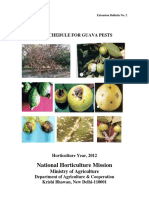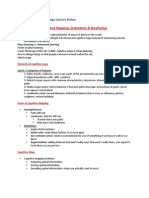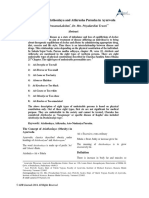Peach Leaf Curl
Peach Leaf Curl
Uploaded by
Generic_PersonaCopyright:
Available Formats
Peach Leaf Curl
Peach Leaf Curl
Uploaded by
Generic_PersonaOriginal Description:
Copyright
Available Formats
Share this document
Did you find this document useful?
Is this content inappropriate?
Copyright:
Available Formats
Peach Leaf Curl
Peach Leaf Curl
Uploaded by
Generic_PersonaCopyright:
Available Formats
report on
PLANT DISEASE
RPD No. 805 September 1999
DEPARTM ENT OF CR OP SCIENCES
UNIVERSITY OF ILLINOIS AT URBANA-CHAMPAIGN
PEACH LEAF CURL AND PLUM POCKETS
Peach leaf curl or leaf blister is caused by the fungus Taphrina deformans. In home plantings, this is one of the most common and widespread diseases of peaches and nectarines, and to a lesser extent of ornamental flowering species of Prunus wherever these plants are grown. Commercial peach orchards are sometimes seriously damaged when a dormant fungicide application has not been made. Plum pockets or bladder plum, caused by the closely related fungi Taphrina communis and occasionally by T. Pruni, is not as widespread Figure 1. Peach lea ves distorted by peach leaf curl disease. Note or as serious as peach leaf curl. Plum pockets reddish p urple areas. Leaves drop in early sum mer. attacks a number of cultivated and wild species of American plums as well as the Canada plum. These diseases are less common on domestic (European) plum and are uncommon on Japanese plum. Neither peach leaf curl nor plum pockets normally kills trees, but both may leave them in a weakened condition and, thus, more susceptible to winter injury and infection by other disease-causing organisms. The fruit corp is reduced for the following year, or even longer. Both diseases are discussed here since control measures and the environmental conditions necessary for infection are the same. Disease development is favored by cool, moist weather (frequent light showers) as the buds break dormancy in early spring.
Symptoms
Leaves. Infected leaves are severely puckered, distorted, thickened, crisp in texture, and curled downward and inward within a month after full bloom (Figure 1). Usually the whole leaf is affected. Such leaves lose their normal green color, which is replaced by red and purple tints. Later, a grayish white velvet spore-producing layer of the Taphrina fungi covers the upper surface of diseased areas. All affected leaves eventually turn yellow or brown, wither, and drop several weeks after infection. Hot, dry weather usually hastens leaf fall. Such leaves are replaced by a second growth of healthy leaves in June and July. The tree, now in a weakened condition, is under stress because of the food reserves used in producing a second crop of leaves.
For further information, contact Mohammad Babadoost, Extension Specialist in Fruit and Vegetable Pathology, Department of Crop Sciences, University of Illinois, UrbanaChampaign (217/333-1523; email: babadoos@uiuc.edu).
University of Illinois Extension provides equal opportunities in programs and employment.
-2With nursery stock, successive attacks for two or more seasons usually kill the tree or stunt its growth to such an extent that it is practically valueless. Blossoms. Peach blossoms also become infected. They are distorted, shrivel, and usually fall before the symptoms are well developed. Twigs. The leaf curl fungus may attack young peach shoots causing the terminal 4 to 5 inches to become stunted, swollen, twisted, and pale yellow or green. Such twigs generally produce nothing but tufts of curled leaves at their tips. Many affected twigs will die back. The tips of plum shoots become greatly enlarged and are often twisted and curled. Fruits. Plum leaves are deformed and curled as in leaf curl of peach and nectarine, but are not as conspicuous. Infected plums 6 to 12 millimeters in diameter develop small, raised, spongy, greenish white spots or blisters that rapidly enlarge and may soon cover the entire fruit. The fleshy young seed soon turns brown, withers, and dies, leaving a hollow cavity surrounded by the ever-enlarging fruit. Bladderlike, misshapened fruits with thick spongy flesh may be up to 10 times or more the size of healthy plums. Infected fruit are reddish at first, but later have a velvety gray appearance (Figure 2). Figure 2. Plum pocke ts fruit and leaf infections. Diseased fruit turn dark brown or black, shrivel, and usually drop prematurely. In years when plum pockets is severe, 50 percent or more of the fruit may be lost. Young peach fruit are distorted and develop irregular, raised, wartlike, colored areas. As the fruit enlarge, they commonly become wrinkled or crack open and lack the normal peach fuzz. Such fruit usually drop prematurely.
Disease Cycle
The disease cycles of the three species of Taphrina are very similar. Soon after the distorted leaves or plum fruit become visible, enlarging asci of the fungi break through the cuticle (Figure 4A). A compact layer of naked asci appear as the powdery gray, feltlike growth on the thickened leaves and plum fruit. Each ascus usually produces eight, one-celled, oval ascospores (Figure 4B, left), which are released into the air as the mature asci rupture. The ascospores multiply by budding inside or outside the ascus (Figures 4A and 4B, right) producing blastospores (conidia) during warm, moist weather. The conidia may continue to bud and eventually produce tremendous numbers of thin- or thick-walled spores (Figure 4C and 4D). The ascospores and conidia are washed, splashed, or blown about and become lodged in the bud scales and in cracks and crevices of the twigs and bark where they germinate (Figure 4E) at once to produce yeast-like colonies. These colonies persist throughout the winter. The spores (conidia) produced by these colonies and ascospores provide the source of infection. During cool, rainy weather in early spring, (optimum 50 to 70F or 15.5 to 21F), from bud swell to bud opening, the spores germinate and infect the swelling leaves and flowers within the buds. The mycelium of the Taphrina fungi grow rapidly between the cells of the host tissues beneath the upper or lower epidermis, stimulating excessive cell growth and enlargement and producing an uneven expansion of the leaf. This results in a wrinkled and
-3puckered appearance. Secondary infections do not generally occur in these fungi since susceptible host tissues soon become highly resistant to invasion. The ascospores and conidia form thick, weather-resistant walls and are capable of surviving hot, dry summers and freezing winters for two years or more. Thus a year of relatively light infection may be followed by a year of severe infection. If preventive measures are NOT taken before trees break dormancy in early spring, control of peach leaf curl and plum pockets is impossible. Trees are susceptible to infection ONLY during the relatively short time between swelling and opening of the buds.
Control
1.
Peach leaf curl and plum pockets are easily controlled. Apply any one of the fungicides listed in Illinois Homeowners Guide to Pest Management, or, for commercial growers, Midwest Tree Fruit Pest Management Handbook, to control these diseases . A single thorough, dormant spray in late fall, winter, or very early spring before the buds begin to swell should provide nearly perfect control. Once the fungi enter the leaf or fruit, these diseases cannot be controlled. Spray all buds, using high pressure. Spray on a dry, calm day when the temperature is over 40 to 45F (4 to 7C). Fungicide dusts will not control peach leaf curl or plum pockets. Follow all fungicide label directions regarding rates, method of application, and precautions. Commercial peach growers normally do not apply a dormant leaf curl spray following a crop year when summer fungicides are used routinely. The frequent use of a summer fungicide detroys the Taphrina ascospores and conidia that would normally overwinter. Thus, a dormant fungicide is most important following a non-crop year. Non-crop years on peaches are common in Illinois and other areas of the Midwest following very cold winters.
Figure 3. Taphrina deformans , peach leaf curl fungus under high-power lab microscope: (A) vertical section of upper surface of peach leaf showing layer of epid erma l cells and co mpact, palisade layer of asci, some contain ing asco spores, which rupture d the leaf cu ticle; (B) tw o asc i, one with 8 ascospores, other ascospores are budding; (C) ascospores budding (form secondary spores or conidia); (D) late budding of ascospore; (E) two ascospores germinating.
2.
If a dormant spray is omitted, and peach leaf curl or plum pockets develop, all that can be done is to maintain tree vigor: (a) fertilize with nitrogen in early spring to stimulate the growth and development of new leaves. Fertilize according to a soil test report. The amount of fertilizer should be controlled to avoid overstimulating the tree; (b) reduce drought stress by periodic irrigations (soil moistened 12 inches deep); (c) thin fruits heavily to reduce the demand on the remaining leaves. Peach, plum, and nectarine cultivars are all about equally susceptible to these diseases.
3.
You might also like
- MoniliniaDocument2 pagesMoniliniaFany25No ratings yet
- Obstetric and Gynecology: A. ColpotomyDocument44 pagesObstetric and Gynecology: A. ColpotomyAloah122346100% (2)
- Plant Disease: Peach Leaf Curl and Plum PocketsDocument4 pagesPlant Disease: Peach Leaf Curl and Plum PocketsGrigore GhecreaNo ratings yet
- Strawberry Leaf ScorchDocument5 pagesStrawberry Leaf ScorchJanath AnthonyNo ratings yet
- Lecture 07 - Disease of Apple (2 Lectures) : - Venturia Inaequalis SymptomsDocument8 pagesLecture 07 - Disease of Apple (2 Lectures) : - Venturia Inaequalis SymptomsAMBIKA BHANDARINo ratings yet
- امراض وافات المشمشDocument42 pagesامراض وافات المشمشhusameldin khalafNo ratings yet
- Peach-Nectarine Pests & MGMTDocument6 pagesPeach-Nectarine Pests & MGMTgshgssgNo ratings yet
- Tranzschelia Discolor In: Peach Rust Caused by CaliforniaDocument9 pagesTranzschelia Discolor In: Peach Rust Caused by CaliforniaSinisaNo ratings yet
- Kentucky Pest News, May 21, 2013Document10 pagesKentucky Pest News, May 21, 2013awpmaintNo ratings yet
- Diseases of CoconutDocument7 pagesDiseases of CoconutKA AngappanNo ratings yet
- 01.apple Scab 402 2021Document11 pages01.apple Scab 402 2021khursheednoman600No ratings yet
- Info Sheet - Bronze Leaf DiseaseDocument2 pagesInfo Sheet - Bronze Leaf Diseaseapi-285114259No ratings yet
- Apple: Diseases and SymptomsDocument5 pagesApple: Diseases and SymptomsAyshee BiswasNo ratings yet
- Field Problems of Fruit CropsDocument80 pagesField Problems of Fruit CropsAnuragBhatnagar100% (2)
- Common Diseases of Leafy GreensDocument6 pagesCommon Diseases of Leafy GreensAgung PurnomoNo ratings yet
- Disease Cucurbits Ja3Document16 pagesDisease Cucurbits Ja3kadaipaneer523No ratings yet
- Aliza, 0102-Mphil-Bot-22, Diseases Incited by AscomycetesDocument19 pagesAliza, 0102-Mphil-Bot-22, Diseases Incited by AscomycetesAqsa AfzalNo ratings yet
- Blight: Symptom Plants Pathogenic Organism Chlorosis TissuesDocument10 pagesBlight: Symptom Plants Pathogenic Organism Chlorosis TissuesIlyas Khan AurakzaiNo ratings yet
- Pests of CoffeeDocument28 pagesPests of Coffeeskumargayathri2kNo ratings yet
- Bacterial Leaf Spot and TipburnDocument4 pagesBacterial Leaf Spot and TipburnAlvin WatinNo ratings yet
- Diseases of Rose and MarigoldDocument24 pagesDiseases of Rose and MarigoldG-4 Nikita kumari MundaNo ratings yet
- Pests of CitrusDocument29 pagesPests of CitrusPalash MondalNo ratings yet
- Ipm Guava Revised Sept2011Document21 pagesIpm Guava Revised Sept2011pegasus86843No ratings yet
- Tree Diseases IDocument2 pagesTree Diseases Idwblakey100% (1)
- Disease Scenery of BD. in TeaDocument22 pagesDisease Scenery of BD. in TeaSaidur Rahman KhanNo ratings yet
- Kentucky Pest News, May 14, 2013Document6 pagesKentucky Pest News, May 14, 2013awpmaintNo ratings yet
- PP348 - PP348 - Florida Blueberry Leaf Disease GuideDocument22 pagesPP348 - PP348 - Florida Blueberry Leaf Disease GuideHussein GonzalezNo ratings yet
- Apple Scab: Disease: Pathogen: HostsDocument9 pagesApple Scab: Disease: Pathogen: Hostssallom1973No ratings yet
- Wilt Caused by Fusarium Oxysporum F.SP - Ciceri Symptoms of The DiseaseDocument7 pagesWilt Caused by Fusarium Oxysporum F.SP - Ciceri Symptoms of The Diseasebhatianitika806No ratings yet
- Scab of LimeDocument5 pagesScab of LimeSALBIAHNo ratings yet
- Boli Cauzate de Factori BioticiDocument130 pagesBoli Cauzate de Factori BioticiLaviniaLaavyNo ratings yet
- Late Blight of PotatoDocument2 pagesLate Blight of PotatoSallu BhaiNo ratings yet
- 2020 Mango Integrated Pest ManagementDocument19 pages2020 Mango Integrated Pest ManagementAgot RosarioNo ratings yet
- Non Mulberry Food Plant Pests and Diseases WordDocument12 pagesNon Mulberry Food Plant Pests and Diseases WordSmart StudentsNo ratings yet
- Covid-19 Treatments by Unique Beutyfull Flower and Stapelia Obducta Endemic Plant South AfricaDocument16 pagesCovid-19 Treatments by Unique Beutyfull Flower and Stapelia Obducta Endemic Plant South AfricaahmedNo ratings yet
- Kentucky Pest News August 9, 2011Document7 pagesKentucky Pest News August 9, 2011awpmaintNo ratings yet
- Lec 07Document13 pagesLec 07Royal BhaskarNo ratings yet
- UmmeLaila (18arid2374) Practical Notebook HORT - 603Document15 pagesUmmeLaila (18arid2374) Practical Notebook HORT - 603UmmelailaNo ratings yet
- Black Pepper Field GuideDocument15 pagesBlack Pepper Field GuidemeaschantyNo ratings yet
- DiseasesDocument20 pagesDiseasesSaziya QuadriNo ratings yet
- Disease in FruitsDocument177 pagesDisease in FruitsJigar PatelNo ratings yet
- PestsDocument15 pagesPestsRaquel DomingoNo ratings yet
- Standsmutdiseasesof SorghumDocument7 pagesStandsmutdiseasesof Sorghumdawit gNo ratings yet
- Plant Diseases IV (VI Sem)Document14 pagesPlant Diseases IV (VI Sem)hambardevishnu2No ratings yet
- Lec 16Document10 pagesLec 16crzysai007No ratings yet
- AGS 322 Diseases of Field Crops and Their ManagementDocument54 pagesAGS 322 Diseases of Field Crops and Their ManagementNavneet KumarNo ratings yet
- Lecture 29Document6 pagesLecture 29P BindumadhaviNo ratings yet
- AGS 322 - Disease-of-Horticultural-Crops-their-ManagementDocument100 pagesAGS 322 - Disease-of-Horticultural-Crops-their-ManagementDixit TagraNo ratings yet
- Practical Manual Field DiseasesDocument91 pagesPractical Manual Field DiseasesDr. Uzma KhanNo ratings yet
- Diseases of RiceDocument7 pagesDiseases of RiceMuneef VkNo ratings yet
- 3 DescriptionDocument8 pages3 DescriptionshujaNo ratings yet
- Watermelon Diseases GuideDocument8 pagesWatermelon Diseases GuideleinadNo ratings yet
- Definition Of: Bean FlyDocument3 pagesDefinition Of: Bean FlyKendrickarbert GapasNo ratings yet
- Mango: Diseases and Symptoms: Powdery MildewDocument8 pagesMango: Diseases and Symptoms: Powdery MildewGlory May AntonioNo ratings yet
- Thrips UCARDocument8 pagesThrips UCARSergio Luís Fernandes PereiraNo ratings yet
- Top Ten Pests in Indiana and How To Control ThemDocument2 pagesTop Ten Pests in Indiana and How To Control Themapi-249697193No ratings yet
- Kentucky Pest News, May 1, 2012Document10 pagesKentucky Pest News, May 1, 2012awpmaintNo ratings yet
- Cabbage DiseasesDocument4 pagesCabbage Diseasesgunjanidhi47No ratings yet
- Name: Francine Palmer Date: June 7, 2011 Class: OHL9 Instructor: Mr. BartleyDocument8 pagesName: Francine Palmer Date: June 7, 2011 Class: OHL9 Instructor: Mr. BartleyFrancine PalmerNo ratings yet
- Identify and Treat Cannabis Diseases, Insects, and DeficienciesFrom EverandIdentify and Treat Cannabis Diseases, Insects, and DeficienciesNo ratings yet
- Crown & Baptist Streets Village Group: ST Re EtDocument1 pageCrown & Baptist Streets Village Group: ST Re EtGeneric_PersonaNo ratings yet
- Earnings of ImmigrantsDocument23 pagesEarnings of ImmigrantsGeneric_PersonaNo ratings yet
- China and Sydney Australias Growing Business PartnershipDocument8 pagesChina and Sydney Australias Growing Business PartnershipGeneric_PersonaNo ratings yet
- Citizens United ReviewDocument5 pagesCitizens United ReviewGeneric_PersonaNo ratings yet
- Sydney Australia's Green Sector OpportunityDocument8 pagesSydney Australia's Green Sector OpportunityGeneric_PersonaNo ratings yet
- Sydney As A Global CityDocument9 pagesSydney As A Global CityGeneric_PersonaNo ratings yet
- A Study On The Effects of Sexually Explicit Advertisement On MemoryDocument10 pagesA Study On The Effects of Sexually Explicit Advertisement On MemoryGeneric_PersonaNo ratings yet
- Environmental Psychology Lecture Notes - Chapter 4 Theories Part 1Document2 pagesEnvironmental Psychology Lecture Notes - Chapter 4 Theories Part 1Generic_Persona100% (1)
- GenEd 111 World History Lecture & Chapter Notes - CH 21Document5 pagesGenEd 111 World History Lecture & Chapter Notes - CH 21Generic_PersonaNo ratings yet
- Environmental Psychology Lecture Notes: Cognitive Maps & Way FindingDocument3 pagesEnvironmental Psychology Lecture Notes: Cognitive Maps & Way FindingGeneric_PersonaNo ratings yet
- Environmental Psychology Lecture Notes - Chapter 4 Theories Part 2Document2 pagesEnvironmental Psychology Lecture Notes - Chapter 4 Theories Part 2Generic_Persona75% (4)
- 1 - 23 and 1 - 25 KleinmanDocument19 pages1 - 23 and 1 - 25 KleinmanLeilaVoscoboynicovaNo ratings yet
- Chapter 16 SchizophreniaDocument9 pagesChapter 16 SchizophreniaCatia FernandesNo ratings yet
- Comparison of The Efficacy of Morning Versus Evening Administration of Telmisartan in Essential HypertensionDocument9 pagesComparison of The Efficacy of Morning Versus Evening Administration of Telmisartan in Essential HypertensionAnna ApriyantiNo ratings yet
- Presentation in NursingDocument2 pagesPresentation in Nursingkamalneemwal0001No ratings yet
- Nosodes and Sarcodes - ClarkeDocument12 pagesNosodes and Sarcodes - Clarkemelos24No ratings yet
- Sexually Transmitted DiseasesDocument30 pagesSexually Transmitted Diseasesmohd ameerNo ratings yet
- A Long and Healthy LifeDocument1 pageA Long and Healthy LifeRaysbel GimenezNo ratings yet
- Jellinger Brazis Localization in Clinical NeurologyDocument1 pageJellinger Brazis Localization in Clinical NeurologyGUSTAVO ALEJANDRO AVERANGA TICONANo ratings yet
- Of Medical InterestDocument3 pagesOf Medical Interestharold jitschak bueno de mesquitaNo ratings yet
- Chapter 13 Diseases of The Musculoskeletal System and Connective Tissue Guideline DifferencesDocument4 pagesChapter 13 Diseases of The Musculoskeletal System and Connective Tissue Guideline DifferencesJuanitoCabatañaLimIIINo ratings yet
- Importance of NutritionDocument4 pagesImportance of Nutritionariadne.georgiou.91No ratings yet
- Nutri5 PDFDocument3 pagesNutri5 PDFfkkfoxNo ratings yet
- Hematologic SystemDocument81 pagesHematologic Systemseigelystic100% (23)
- Akld Paper I 2014Document66 pagesAkld Paper I 2014dtonnnssonNo ratings yet
- Mtap1 MycologyDocument6 pagesMtap1 MycologyALLANA YZABELLE LEA�ONo ratings yet
- Concept of Atisthoulaya and Atikrusha Purusha in AyurvedaDocument7 pagesConcept of Atisthoulaya and Atikrusha Purusha in AyurvedaAdvanced Research PublicationsNo ratings yet
- (PDF Download) Precalculus 6th Edition by Margaret L. Lial Fulll ChapterDocument34 pages(PDF Download) Precalculus 6th Edition by Margaret L. Lial Fulll Chapterweinebeekum100% (9)
- Pemicu 8 Blok Saraf & Kejiwaan: Pandu 405140087Document57 pagesPemicu 8 Blok Saraf & Kejiwaan: Pandu 405140087ElsaNo ratings yet
- Divisions of CriminologyDocument4 pagesDivisions of CriminologyAsuna YuukiNo ratings yet
- Food Vision Asia 29 April Regina Moench PfannerDocument31 pagesFood Vision Asia 29 April Regina Moench PfannersedditNo ratings yet
- Leprosy DiseaseDocument46 pagesLeprosy Diseaseshivamg.sg1234No ratings yet
- A Case Study On Ayurvedic Management of Manyasthambha With Special Reference To Cervical SpondylosisDocument3 pagesA Case Study On Ayurvedic Management of Manyasthambha With Special Reference To Cervical SpondylosisEditor IJTSRDNo ratings yet
- Seventh House & aSTROLOGYDocument11 pagesSeventh House & aSTROLOGYSuresh Sharma100% (1)
- Parasitology SummaryDocument7 pagesParasitology Summaryshiner99100% (1)
- Intracerebral Hemorrhage (CVA) : Angeles University Foundation College of Nursing A.Y. 2016-2017Document203 pagesIntracerebral Hemorrhage (CVA) : Angeles University Foundation College of Nursing A.Y. 2016-2017Reisabelle LabianoNo ratings yet
- Emergency Care FormsDocument17 pagesEmergency Care FormsBilal SalamehNo ratings yet
- Preconception Risk Assessment Tool (Page 1 of 2) : State of Illinois Illinois Department of Healthcare and Family ServicesDocument4 pagesPreconception Risk Assessment Tool (Page 1 of 2) : State of Illinois Illinois Department of Healthcare and Family ServicesyieviaNo ratings yet
- Drugs Affecting The Body System and Nursing ConsiderationsDocument7 pagesDrugs Affecting The Body System and Nursing ConsiderationsLOVELLE GRACE DE JESUSNo ratings yet
- EENT Exam 2Document3 pagesEENT Exam 2Beda MalecdanNo ratings yet




































































































